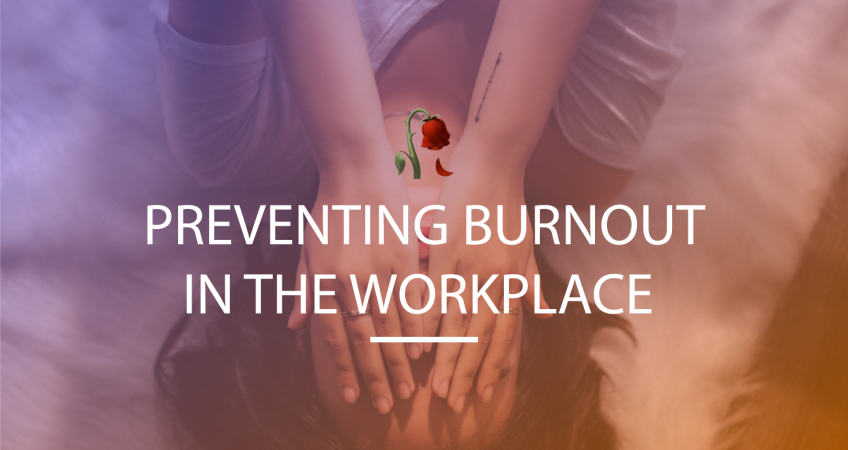
Preventing burnout in the workplace
Have you ever heard of the term burnout? It might sound like a slang or something cool to be said about something trivial. However, burnout is a real thing that is happening today, especially with rapidly growing businesses and a fast economy. We as business leaders have to take note about mental health in the workplace as it drastically affects your staff wellbeing as well as productivity.
What is burnout
First off, what exactly is burnout? Scientists have been struggling to put a definitive name on the condition but burnout is essentially a downward spiral triggered by environmental stressors for occupational reasons. It is a state of exhaustion, be it emotional, physical or mental caused by prolonged stress. Almost like you are ‘giving up’. Imagine when faced with stress or excessive work for long periods of time, you might start to feel overwhelmed and unable to meet these demands placed upon you. After time, interest and motivation wanes and disappears altogether, leaving behind a sense of being drained and feeling like you are not making a difference. It is also about feeling insignificant.
Effects of burnout
The effects of burnout includes reduction of productivity, feeling of hopelessness, cynicism and resentfulness. Burnout spills easily over into other aspects of life such as social, work and home. It also weakens the immune system which makes the body susceptible to illnesses. Notice that the symptoms of burnout are very similar to depression. That’s because having burnout can dangerously lead to that. We would like to think that burnout is technically depression but instead is due to occupational causes.
Stress vs Burnout?
You must be wondering isn’t stress and burnout the same thing? Well no, because stress can still be under control and handled. In fact, stress can be healthy when managed well and lead to more breakthroughs and higher productivity but burnout is the opposite. People with burnout don’t see any hope of change in their situation. While stress feels like you are drowning in work, burnout is the sense of being way past that point where you get all dried up.
WHO ( World Health Organisation ) has recognised burnout to be an occupational phenomenon and not a medical condition. It therefore should not be used for experiences in other areas of life. Which means most of what causes burnout is due to work and can be prevented and treated externally. In fact, “passion-driven and caregiving occupation such as doctors and nurses are some of the most susceptible to burnout, and suicide rates among caregivers are dramatically higher than that of the general public — 40% higher for men and 130% higher for women. A study by the APA claims that burned-out employees are 2.6 times as likely to be actively seeking a different job, 63% more likely to take a sick day, and 23% more likely to visit the emergency room.”
With the amount of information that we have, how can we as leaders prevent this from happening under our management? Or as employees, could we voice out this problem to those who can make a difference?
What causes burnout?
So, looking into a deeper level, what are some of the specific things that happen in the workplace that causes burnout? A survey of 7,500 full-time employees by Gallup found the top five reasons for burnout are:
- Unfair treatment at work
- Unmanageable workload
- Lack of role clarity
- Lack of communication and support from their manager
- Unreasonable time pressure
Of course these reasons can be subjective, maybe to the employee it seems like the workload is proving to be too much or they are being treated unfairly. But in the managers’ or leaders’ eyes, they are fully capable of handling it. it is a matter of perspective. This is where good communication and planning comes in. We have to know what employees are capable of while it is also up to them to know it as well. We will get into further details on how to implement prevention strategies for burnout later on in the post.
According to the WHO, “risks to their mental health includes,
- inadequate health and safety policies;
- poor communication and management practices;
- limited participation in decision-making or low control over one’s area of work;
- low levels of support for employees;
- inflexible working hours; and
- unclear tasks or organisational objectives.
It may also be related to job content whereby they are assigned to a job that is unsuitable for their competencies. As mentioned above, some jobs carry a higher personal risk than others because of the amount of stress that they face in their day to day lives.”
The person vs the workplace
Whenever someone is notably having burnout we usually suggest for them to make some internal mindset changes such as thinking on the bright side, have better breathing techniques, spending more time outside or doing zen yoga. This goes the same for depression and anxiety. However, this is only but a surface level form of treatment and the band-aid will almost always fall off. The issue goes beyond that.
Burnout usually stems from risk factors that may be present in the working environment. But before we get into this we have to realise that this problem is never the worker’s individual problem and cannot be treated as such. Some of these risks include insufficient resources in order to complete a certain task, organisational and managerial conditions, or having inadequate leadership support. Where depression and mental illness are largely internal, burnout is external which means tons of these risks are preventable.
We have to realise that providing a good working environment is crucial in order to prevent mental disorders in employees. Ask ourselves, what is making my employees feel so dejected? What is wrong with our work environment for them to be experiencing these negative feelings? How can I make it comfortable and safe for them to work here every day? Pretend you’re an objective therapist that is diagnosing your own actions as leaders as well as the conditions that you’re providing.
All problems start with a root cause, find it and treat it. Employee satisfaction is directly tied to prevention of burnout.

Two Factor Theory (Motivation – Hygiene)
While doing research for this post, we discovered a theory by psychologist Frederick Herzberg called the Herzberg Motivation Theory model or Two Factor Theory. This theory states that there are two factors that an organisation can take action to adjust to influence and maintain a healthy workplace environment.
First of there are motivators. These motivators are what encourages employees to continue working for you. Like a supporter. They include achievements, recognition, responsibility, advancement and growth.
Secondly, hygiene. Hygiene are basic needs that an employee requires. Almost like food, water and shelter. These won’t encourage them to work harder but when not present, will cause them to become demoralised and unmotivated. They include company policies, supervision, relationships, work conditions, renumeration, salary and security.
Motivating factors are referred to as satisfactory while hygiene as dissatisfactory. These two factors instead of being codependent, they are in fact independent of each other which means that managers and leaders can recognise and attend to each one separately. The ideal state is to have high motivation-high hygiene, but there are instances of high motivation-low hygiene, high hygiene-low motivation, etc. These leads to different dynamics in the workplace.
Though, there are some limitations to this theory, it provides a good gauge of how you are able to take steps towards positive change.
Communication
Establishing good communication is the key to be able to implement change. One way to maintain employee satisfaction, is to remove hygiene stressors. However each individual have different perceptions of hygiene stressors so it is super important to establish good communication and find out what is lacking for them. It can be as simple as changing the coffee packets or replacing the toilet paper etc. Yet it can go bigger such as ensuring your team member is feeling supported, no salary disparities and to make the job meaningful for them. Make them feel valued.
Once basic hygiene needs are met, you can then move on to boosting the job satisfaction, increase motivators. For instance, improving the content of the job, quality of client projects etc. You can give your employees more complex tasks which challenges them professionally without pushing any borders, helping them grow in their skills and make the job more interesting. Giving them more variety to explore in other areas as well as delegating certain responsibility to your employees if you know that they can handle it. This is a good way to ensure that they are mentally challenged and not stuck in a rut.
Follow up
Of course once changes have been made, follow up. Catch up with your employees, sit down with them and have a talk about how things can be better. Check up with them and observe if they are feeling satisfied at their job. As a leader you have to be on top of it. Ask, always ask questions back to them.
Burnout is though common, it is also very preventable. It requires good organisational hygiene, sufficient motivation, asking effective questions and ensuring wellness is part of your well-being strategy plan. If you have happy employees, naturally you will have a happier, meaningful and more successful business.
Sources
https://hbr.org/2019/12/burnout-is-about-your-workplace-not-your-people
https://www.who.int/mental_health/evidence/burn-out/en/
https://expertprogrammanagement.com/2018/04/herzbergs-two-factor-theory/
